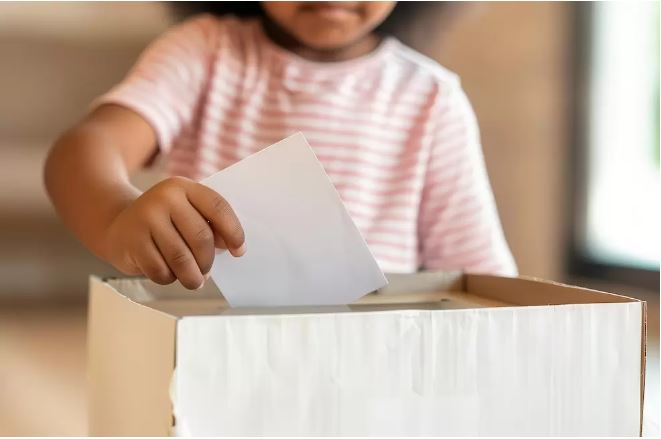
Signs of the election are everywhere. In communities across the country, there are lawn signs, billboards, and advertisements on TV. There is energy in the air and strong feelings in many homes about hopes and dreams concerning the election results. Children observe all of this as the election affects our communities.
Young children are incredibly perceptive. They see and hear the world around them and yearn to make sense of it all. Through play, children experience story-telling, role-playing, hypothesizing and more. When you introduce young children to the concepts of democracy and citizenship you are introducing them to a fundamental value of our American educational system. The values that the democratic process teaches are important to learn regardless of whether or not it is an election year. As educators and parents, we can explicitly name these values for young children and help them engage with what they are noticing.
There are a number of key values from our democratic process that we can bring to our youngest learners. By doing so we can help create a more empowered, socially conscious and active generation in the future. These include but are not limited to the ideas that:
It is important to remember that these values are also critical elements of excellent early childhood education. Quality early childhood education reflects good democratic education, which reflects the basic building blocks of a good democracy.
We can include these values through a variety of developmentally appropriate election play and exploration. Children three-five years old are asking questions about voting and are forming their own strong opinions about the world around them. In classrooms, preschool aged children enjoy having the opportunity to engage with themes over a period of time. Introducing voting themes and vocabulary ahead of the election gives children the opportunity to feel capable of understanding the world around them. Also, extending election play past the election itself can help children work through feelings or ideas that they might hear surrounding them. Ways to incorporate this kind of exploration include:
A mock election can happen at home or at school. It could focus on what children are having for snack or what to name the new class fish. Mock elections can be teacher directed; however, the more input children have, the more invested they will be in the process. There are many things to consider when creating your own mock election:
Using words like: Election, Candidate, Vote, Polls, Ballot, Ballot Box, Government, Power, Campaign etc.
Unlike voting where we raise our hands, our ballots are secret. We do not need to prevent children from sharing their vote; however, it is helpful for them to see that there is a difference between privately submitting a ballot and publicly raising a hand.
Books give children a context that voting is something that has been part of being an American for a very long time. Books also help children understand that this election will not be their only election. An election will happen again and eventually they will be able to vote as well.
Voting is for everyone. Children can interview family members or people in their school community. Interviews are an opportunity to interact with community members who they may not see every day. Also, if children are unable to conduct in-person interviews, children can still ask questions and learn about the voting process through a video call. Children can ask:
Before the interview, ask children what they want to learn about voting – answering their questions and encouraging their curiosity and is empowering!
There are ways for a teacher to facilitate an interview without endorsing a political candidate yet still exposing children to the breadth of the democratic process. If you are a teacher, make sure to connect with the person you are interviewing ahead of time to share what themes and conversations are happening in your class and ensure that the interview can stay focused and non-partisan.
These are just a few ways to provide opportunities for young children to feel part of the process. They know that the issues are important and that the grown-ups in their world are voting because they care about the future of our country for themselves and their children. Through talking about this process in our schools and homes we are empowering our children to know that they are part of a democratic society where each ballot gives voice and the power to change. We hope that this season, all of you and all children will have an opportunity to VOTE and use your power to make the change you want to see in the world.
For more resources, check out: https://www.naeyc.org/our-work/public-policy-advocacy/gotv-activities-nonprofits